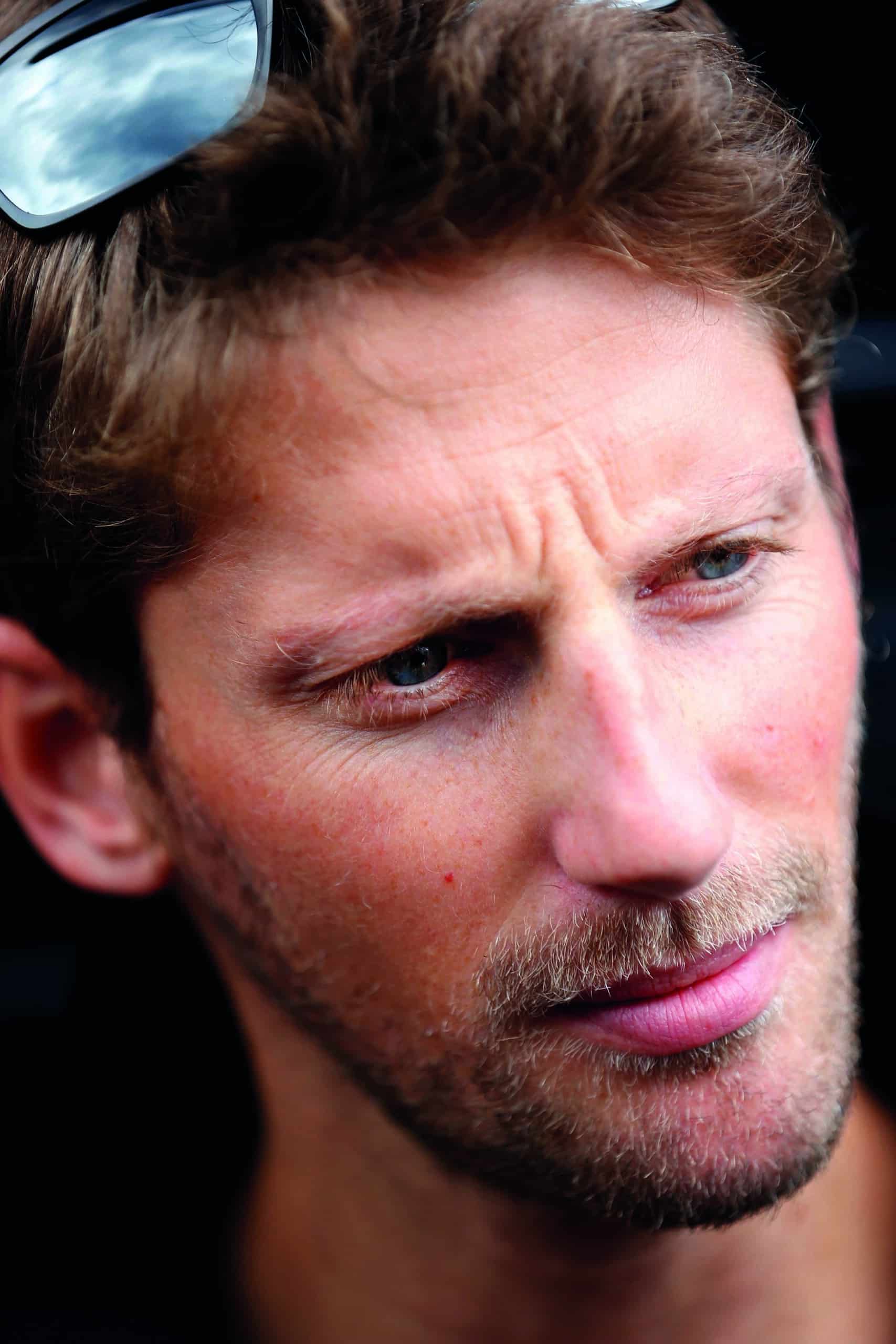Romain Grosjean: 'My F1 career is coming to an end and I can't do anything about it'
Is Romain Grosjean the quickest F1 star never to win a grand prix? Mark Hughes and the Haas driver discuss the crashes, the near-misses and what comes next
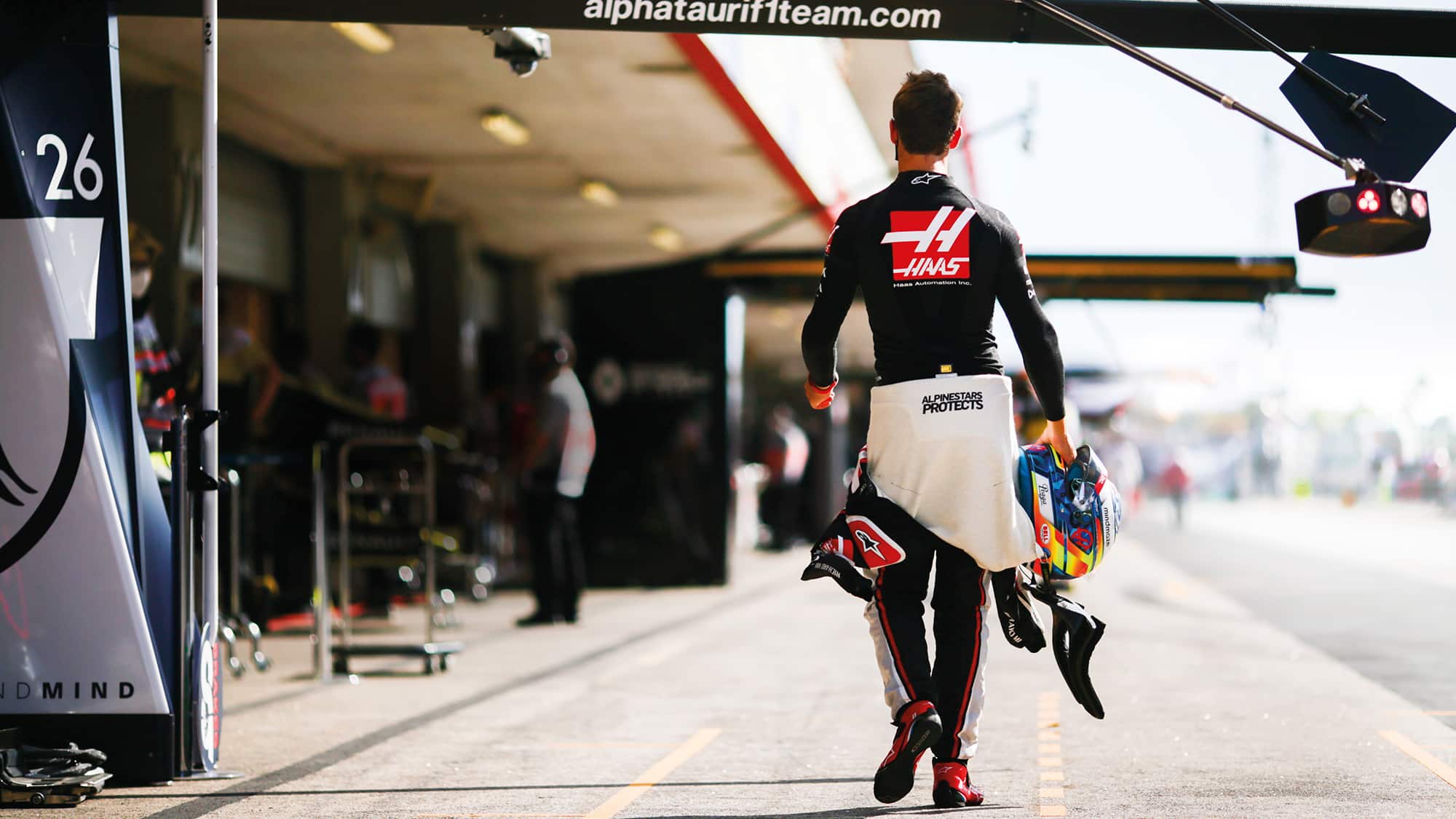
Looking for a place to hang up his F1 boots? Nice-guy Romain Grosjean is considering a switch to IndyCar
Does Romain Grosjean, coming to the end of his F1 career, still feel he could go up against anyone? “Yes, for sure,” he instantly fires back. “Put me in a Mercedes and some days Lewis would be better than me, some days I’d be better than him, just depending on the feeling on the day. I know I’m one of the five fastest, let’s say. Some people may disagree, fine. But I know that if you gave me a Mercedes, I would win the race.”
It isn’t going to happen, of course. But as much as his claim may sound ridiculous, it’s spoken by one of F1’s fastest drivers of the last few years. His name does not appear even once in the grand prix winner’s list after 11 seasons. But that massively undersells him. Aside from the fact that he was in a semi-competitive car for only two of those 11 seasons, this was one of the few drivers ever to have caused the Pirelli engineers to see things on telemetry they hitherto didn’t believe possible, who caused them to have to recalibrate their analysis tools. Him and Hamilton, they said (though this was before the time of Max Verstappen).
His passing from F1 should be marked. For he has been a singular character and driver, not just another who ultimately was not a potential champion and who therefore eventually ran out of options. He had the spark of greatness but it was repeatedly extinguished. The supporting qualities needed to maximise that basic ability were perhaps lacking. He remains a vulnerable personality, too open for his own good, maybe not tough enough to let criticism wash off him, his emotions not always fully under control.
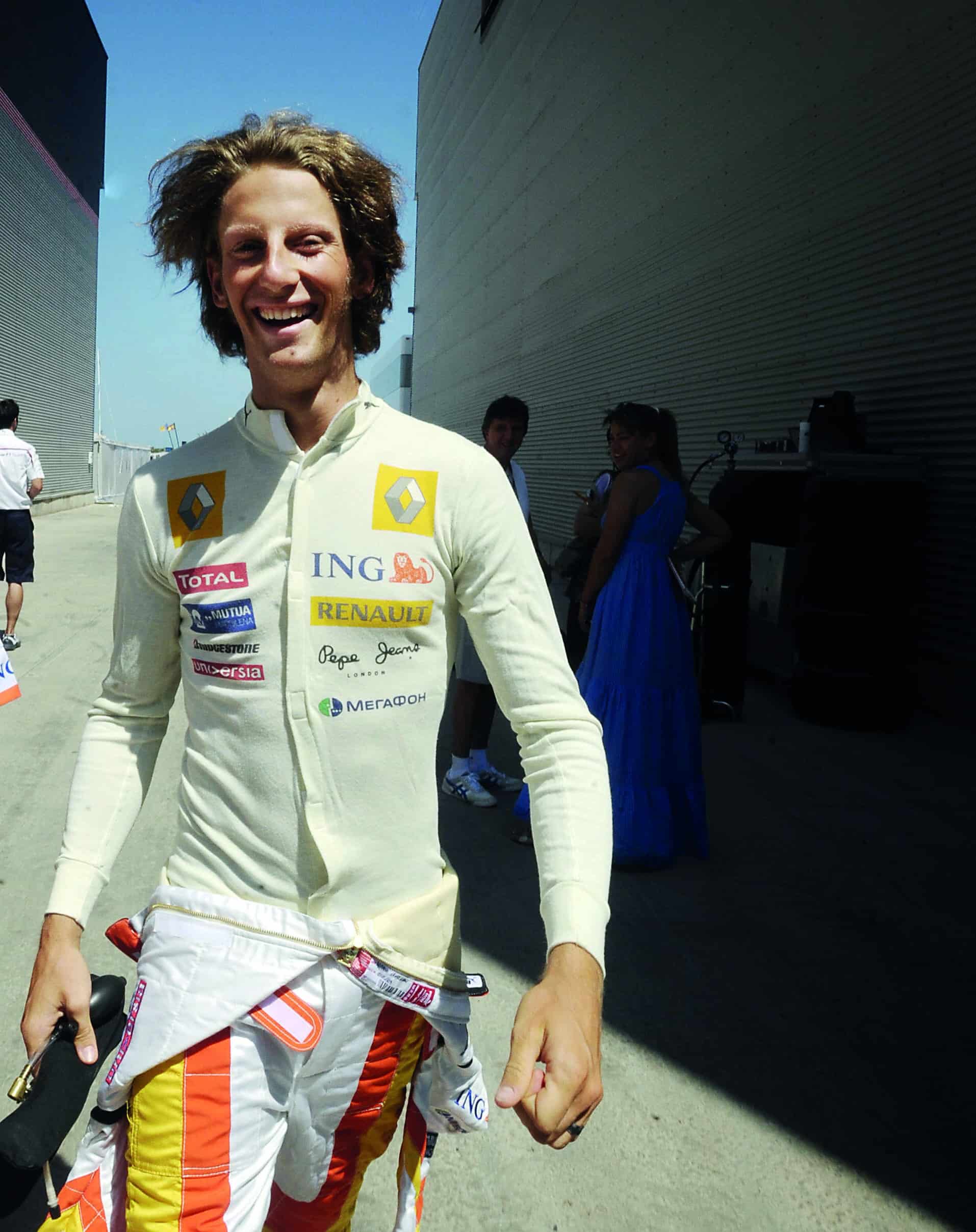
New kid on the block, Valencia 2009
“This is who I am,” he says. “Maybe I could have created a role, a different character for F1. But everyone saying there’s no personalities in F1: ‘I’m happy I’ve won; I’m disappointed I’ve not won.’ Well yes, we all know that, it’s quite boring. But yes, I guess I was outside of the standard and that made me an easy target and sometimes I say things I feel and they may not be right. I’m the first to admit when I’m wrong but sometimes the damage is done because I said what I felt in the moment and I should have thought about it more. I’m not going to change now. I will teach my kids to be honest. I think honesty and being who we are is one of the most important values we have.”
The more blows fate dealt, the harder he tried; the harder he tried, the more trouble he got himself into. But in that trying, and between those troubles, his peaks lit up the track like few others. That combination of emotion and extreme speed made for a sometimes very exciting performer.
After a false start in 2009, he was gifted a rare second chance in 2012-13, with a seat in a competitive Lotus. In what were effectively his rookie and sophomore seasons, his performances then were often extraordinary, albeit punctuated by an infamous incident and misjudgement in 2012. In that often-startling first full season were sown the seeds that would come to define his career. For good and bad.
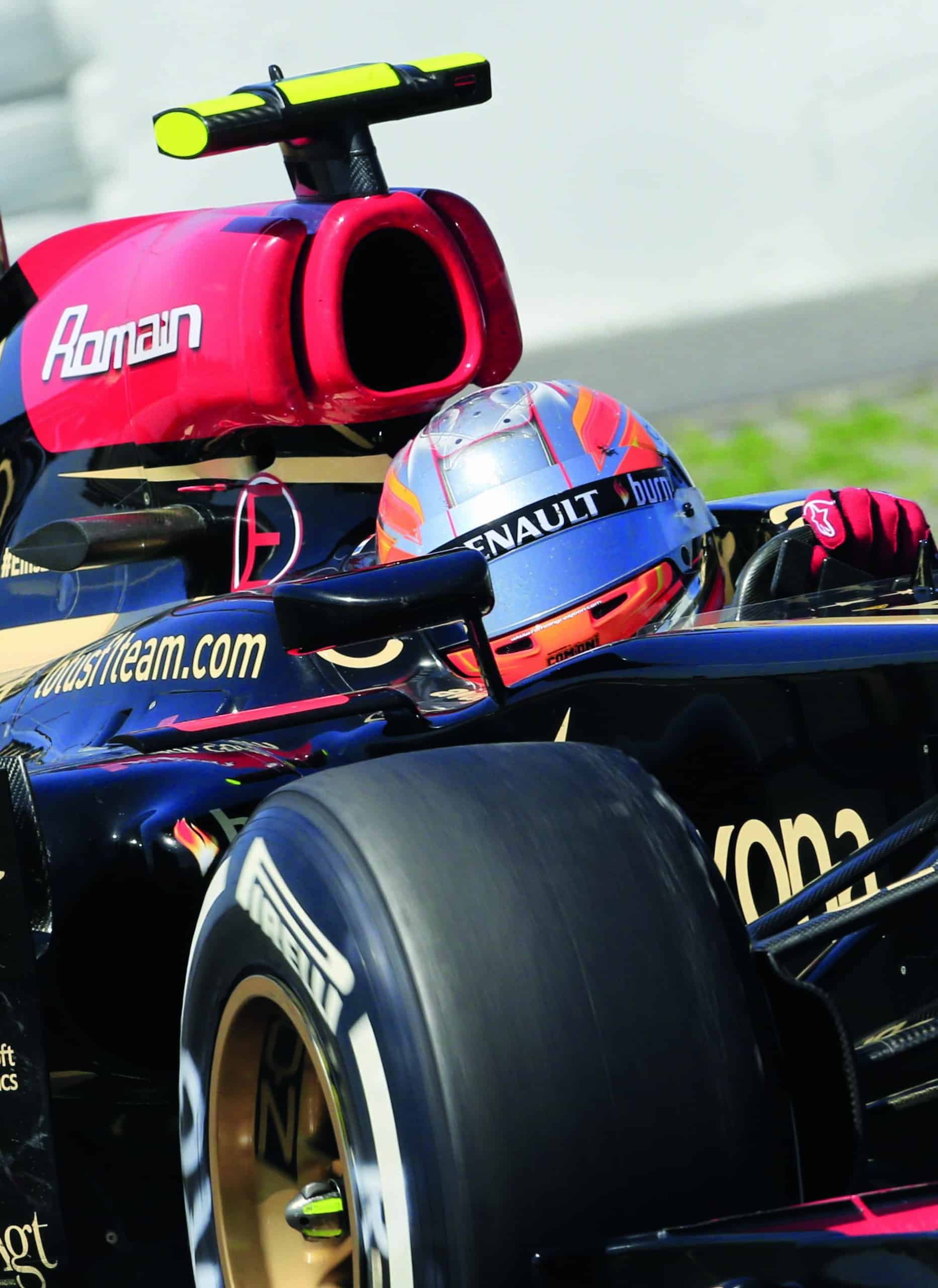
A decent day at the office for Lotus in 2013 with Grosjean third in the German GP
Many times in those first two Lotus years he flew close to glory, avoiding it sometimes only by the skin of his teeth, through no fault of his own. Since, there have been occasional reminders of his special talent, but the last few of those 11 seasons have been somewhat low-key with the struggling Haas team, far removed from those afternoons in the summer of 2013 when he was the only one threatening to break Sebastian Vettel’s nine-in-a-row sequence of victories with Red Bull. With a car that was good, but not Red Bull good. Twice he made Vettel sweat hard for victory and on one of those occasions was only denied what would have been a spectacular triumph over a faster car by the unfortunate timing of a safety vehicle. It wasn’t just that Grosjean had the speed; he had the style as well. His best manoeuvres were audacious, ambushing out of nowhere, requiring super-fine judgement and balls. He had the moves, the talent. But somehow the spark never caught, the flame never took hold.
We caught up with him in reflective mood, 34 years old as the last few grands prix of this season were ticked off in the midst of him investigating the possibility of switching to IndyCar. “I know it’s coming to an end and there’s nothing I can do about it,” he says. Even in the sad, resigned words, there is the ever-present smile. He’s a super-nice guy, despite the impression the casual observer might get from his radio messages in the heat of battle. Those communications are impassioned rather than angry – and emotion is at the heart of his approach, the fuel which has sometimes taken him to the edge of feasibility and, every once in a while, pulled off something quite special. It’s also contributed to those scrapes.
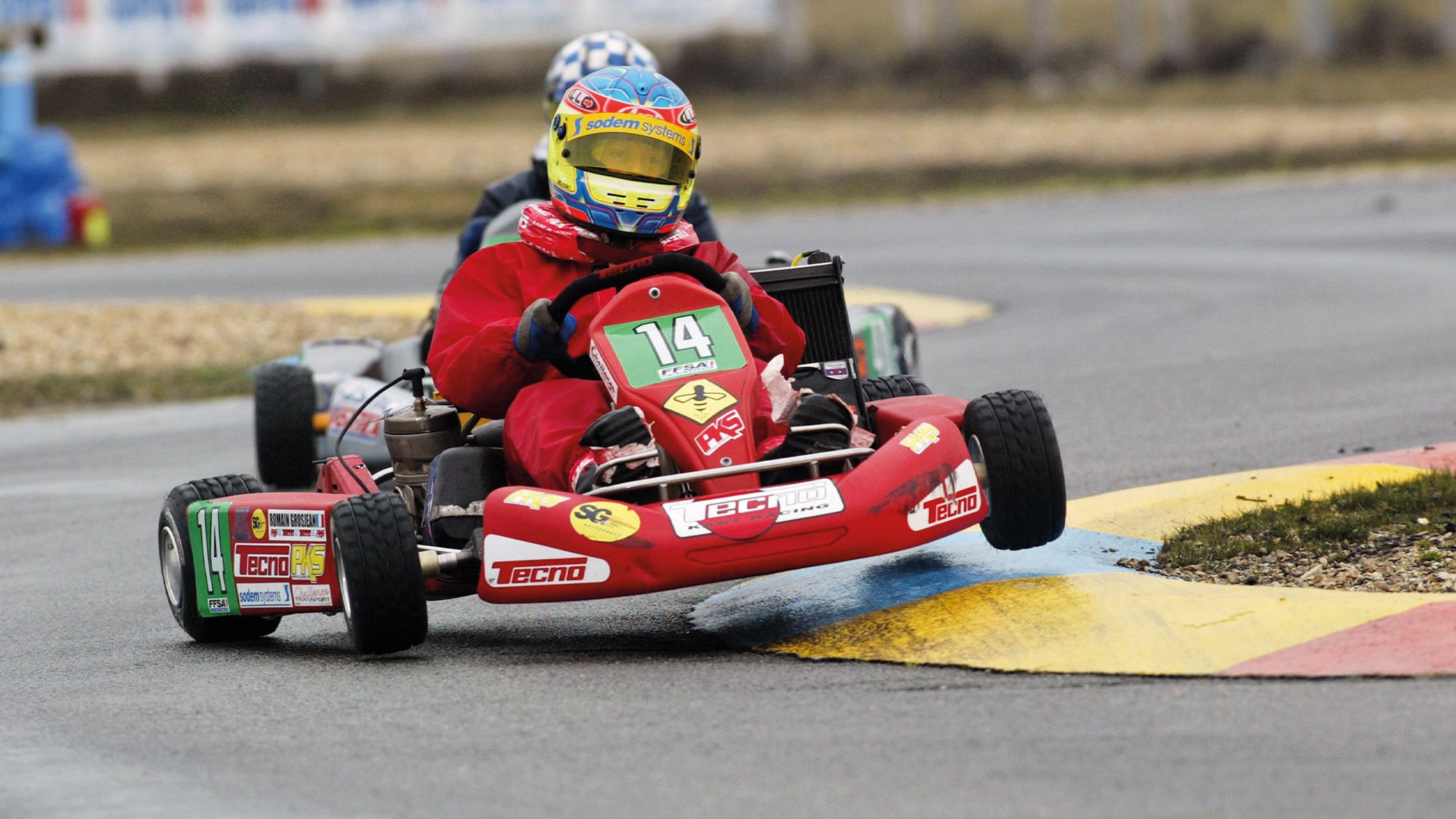
Late to karting at 14
“I still feel I have a lot to give F1 but there aren’t any seats, so… it is what it is. I want to go racing where I can win again.”
Like in his pre-F1 career, after he’d stumbled into the sport. A late starter in karts at 14, supported by a sport-loving father, he did have high-level sporting DNA in his blood; his grandfather, Fernand Grosjean, was a world championship downhill skier in the 1950s. It was winning a talent scholarship for the Formula Lista championship that gave him his break into car racing in 2003, his dominance of that title paving the way for a move to Formula Renault 2-litre, in which he was French champion in his second year. But that was as far as his father’s backing stretched.

Grandfather Fernand Grosjean was in the 1948 and 1952 Winter Olympics
“We didn’t have the money for F3 so we looked for a junior programme to get on. First we approached Red Bull. I was racing under a Swiss licence and they said, ‘Sorry, we already have Sébastien Buemi. We don’t need another Swiss driver.’ I told them I also held French nationality, but they couldn’t sell their product in France. Then I met [Renault driver development director] Bruno Michel and he too told me we’re not interested in a Swiss driver. ‘But I’m also French,’ I told him. ‘Oh,’ he said, ‘that could be interesting.’ I signed and they said that this could be the longest contract of your life until your wedding.”
He was on his way, so it seemed. With his career fully backed by Renault and Total, the structure was in place to facilitate long-term planning. He was being groomed for a great career. All he had to do was deliver, which he duly did. “Throughout my career, it was first year in a formula to learn, second year win the title.” After taking pole and two wins at the demanding Pau circuit in his first F3 year of 2006, he won the 2007 European series. As a GP2 rookie, he won the 2008 Asia series in swashbuckling style and was a title contender in the main series. He dominated the start of the 2009 season but didn’t complete the year because F1 had come calling. Renault had lost patience with Nelson Piquet Jr and pressured the man running its team, Flavio Briatore, into replacing him with young prospect Grosjean.
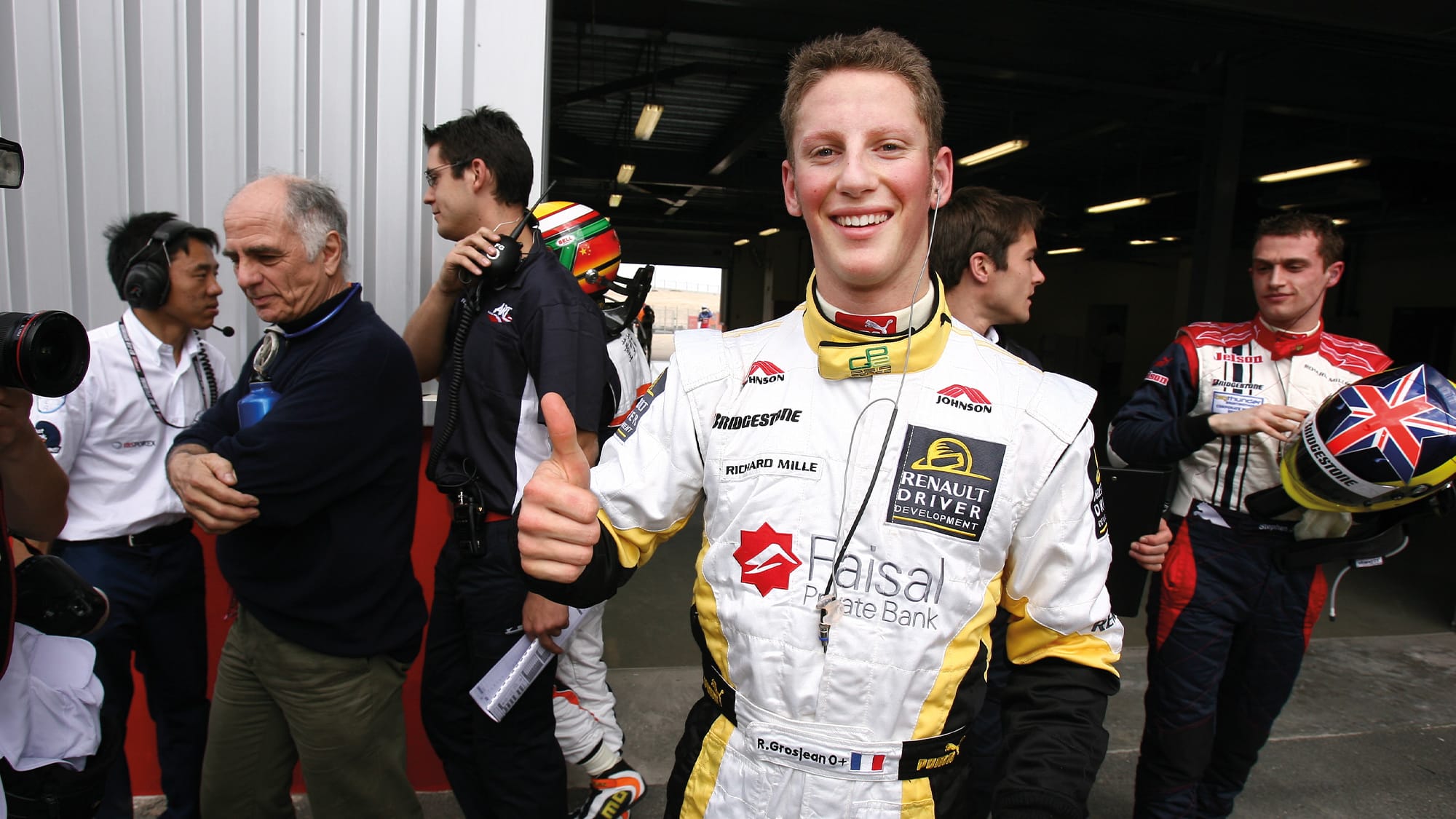
A driver in the inaugural GP2 Asia Series
Here he was, thrust into F1 at the European Grand Prix in Valencia, with no experience of the car – and Fernando Alonso as his team-mate. “I hadn’t even done any straight-line running in the R29. Everything was new.” In Q1 he trailed Alonso by 0.167sec. In Q2 by 0.323sec. With no preparation, it was a truly impressive effort. “I was told I should just treat the seven races in 2009 as practice for a full season in 2010. But it didn’t happen like that…”
Piquet had not taken kindly to being dropped and had informed the FIA of how he had deliberately spun in the 2008 Singapore Grand Prix, as instructed by Briatore, in order to give Alonso the race. The scandal rocked F1, got Briatore banned from the sport and led Renault – in dire financial straits since the 2008 economic meltdown – to sell 75 per cent of the team to a venture capital company, Genii. Just like that, the rug was pulled from Grosjean’s career, no longer with the big manufacturer backing. There was no place for him in 2010.
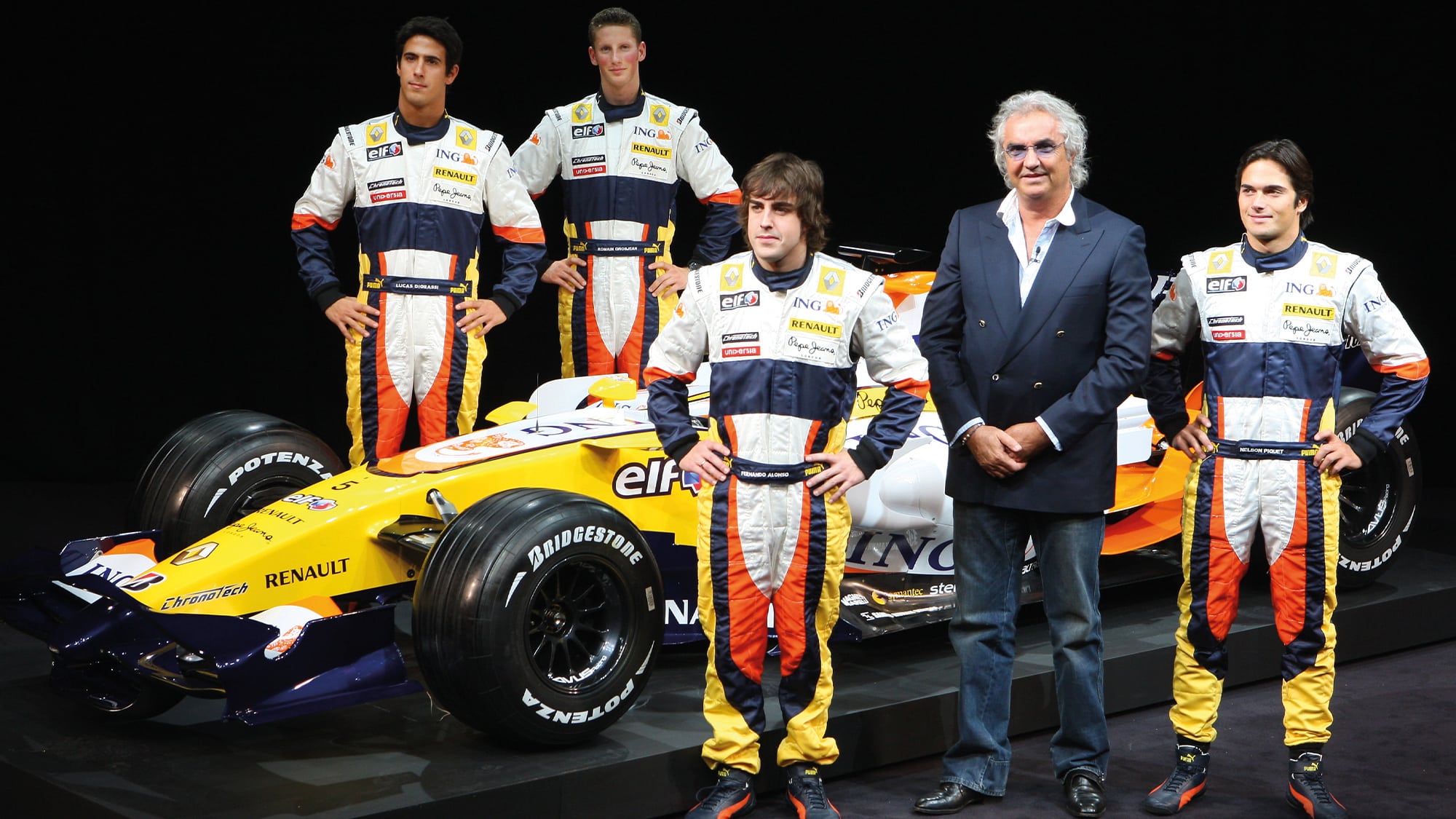
Renault drivers for 2008 with boss Flavio Briatore, a long-time fan of Grosjean
“The new owners just wanted to wipe the slate clean after the scandal. They wanted everything new. I was perceived to be from the previous Briatore era even though I’d only been there for seven races. Also, I didn’t behave well. I’d been there as a reserve driver for a year and during that time it was Alonso and Piquet. Alonso was a double world champion and Piquet was son of a world champion, and they weren’t on the best behaviour. The only reference I had was those guys. I didn’t act as I should have done because I didn’t really have anyone to tell me to be careful, do that, don’t do that. I wasn’t prepared.”
He was raw, shy, had total belief in his ability and came across to the team as difficult, reluctant to take instruction. There was no big pushback from the Enstone personnel when the new owners – with Robert Kubica under contract to replace the departing Alonso – decided to replace Grosjean with the financially-backed Vitaly Petrov. The F1 dream seemed to be over. Devastated, Grosjean turned his back on the sport, with ambitions to become a chef. “If I’d got into the chef’s school in Paris I applied for [he was turned down], I might never have returned to racing.”
An offer came to race a Ford GT1 in 2010 and with nothing else on the table he took it. But watching over him and keeping in close contact was Éric Boullier, who was a believer but who could also see the faults. They’d known each other from GP2 when Boullier had links with the ART team for which he’d driven. Boullier had been made team principal of Lotus, the renamed Renault team, by the new owners. He wanted to bring Grosjean back, but needed to be convinced of his attitude and commitment first. He was placed back in GP2 for 2011 with the recently-struggling DAMS team – and won the championship that he’d been on course to take two years earlier. He was given a Friday try out in practice by Lotus for that year’s Brazilian Grand Prix – and lapped faster than the regular driver of the car, Bruno Senna. That clinched it; he would go back to F1 in 2012. Refreshed and more mature.
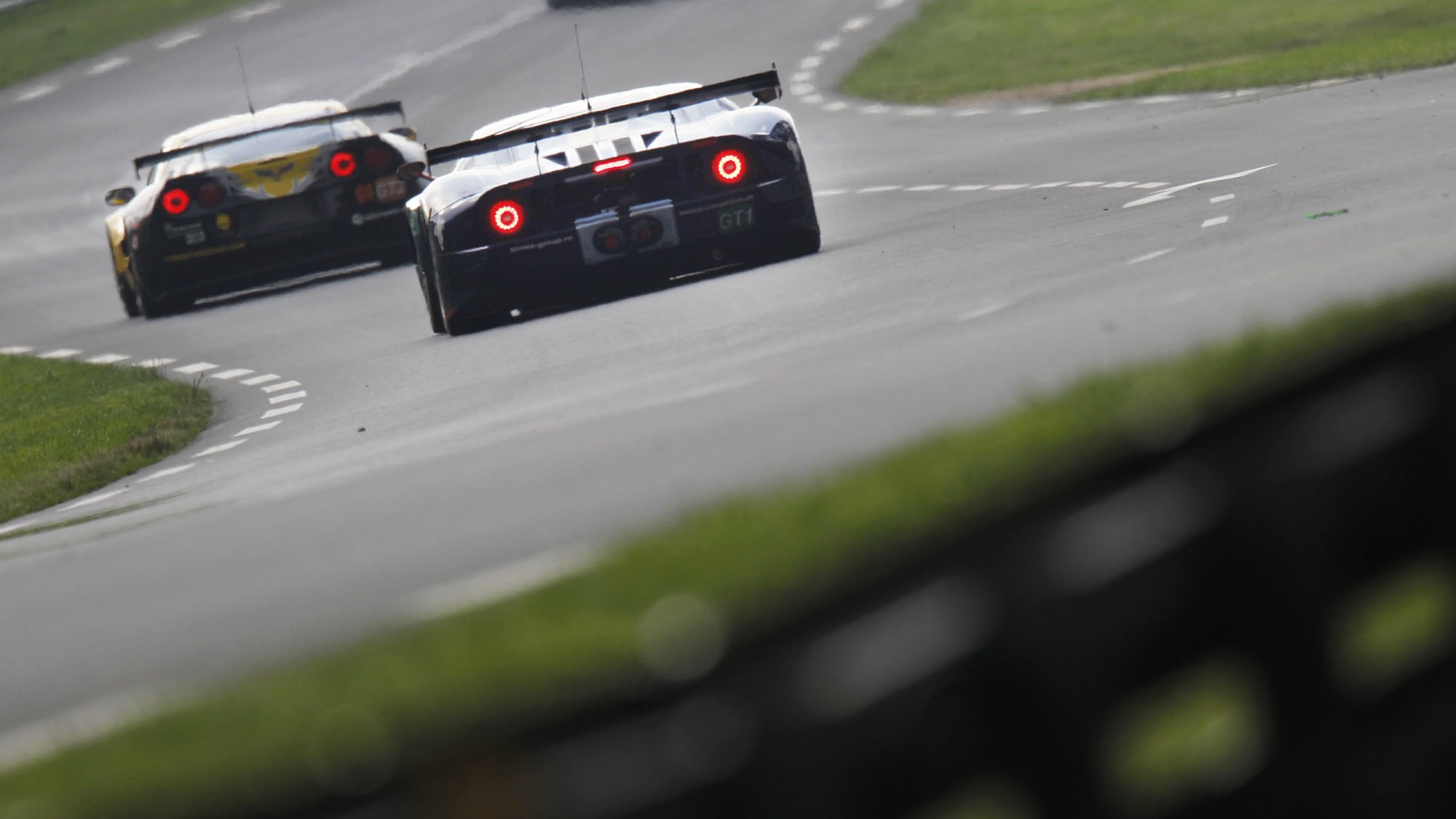
Following his first F1 stint, Grosjean moved to GT racing and made his Le Mans 24 Hours debut in 2010 co-driving a Ford GT1
On his return, in what was effectively his rookie season, he qualified third. In his fourth race back he was on the podium. In Valencia he was magnificent. A breathtaking shimmy from the start vaulted him from sixth to third. He remained there for a time, stuck behind Hamilton’s McLaren as Vettel escaped and pulled out a big lead. Grosjean wore Hamilton down and eventually squeezed past in an exquisitely judged move into the chicane. He then began to hunt Vettel, but it probably wasn’t going to happen. The Red Bull’s lead was too big. Then a safety car bunched up the field, which was good in that it got him onto Vettel’s tail, but bad in that it brought Alonso’s Ferrari – previously over 12sec behind – onto his tail. Alonso was able to put a move on the Lotus at the restart. But Grosjean came back at him and for the next few laps their duel lit up the whole place. Then Vettel and Grosjean suffered identical alternator failures on their Renault engines, paving the way for Alonso.
It turned out to be a pivotal race for Grosjean. “I was so close to winning there that every time I was in the car after that I was trying 101 per cent right from the start – because I felt the win was there, just almost within reach. I lost the big picture.” He began making errors. In between them, he pushed Hamilton hard for victory in Budapest but the safety car’s timing dropped him to third. Then came Spa and his misjudgement off the startline in locking wheels with Hamilton and triggering a multi-car first-corner accident. He was banned for a race – and came back cowed and very tame in the last few races of the season.
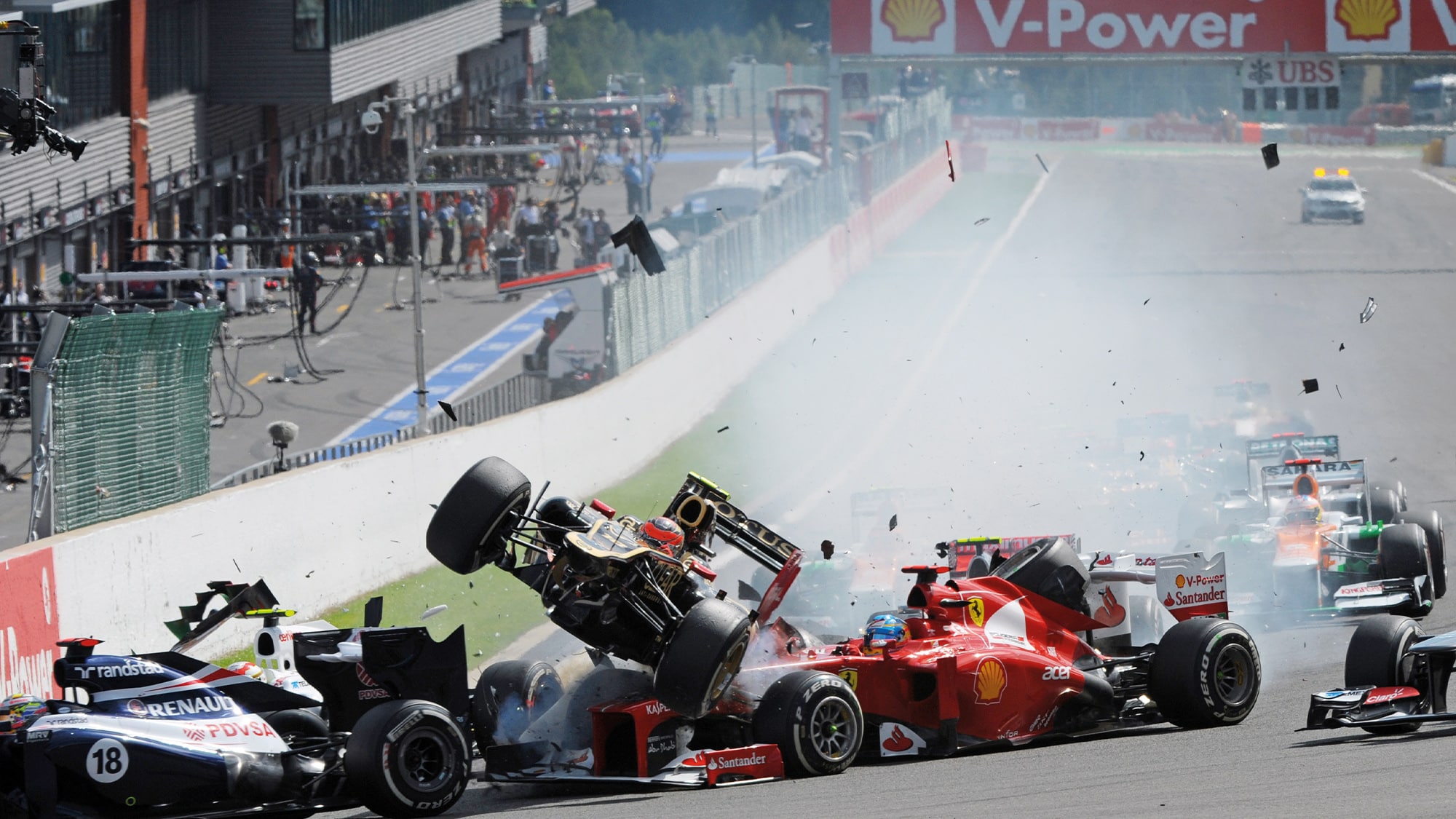
Disaster at Spa in 2012 as Grosjean gains altitude in a collision involving Hamilton Pérez and Alonso. Grosjean was banned for the next race
“I really got hurt by what happened at Spa. I got this reputation and it was very hard to bounce back from that. A lot of people just remembered the crashes and forget that for a rookie – which is what I was really – it was an outstanding season. I don’t think we’ve seen a rookie season like that for a long time.” Three podiums, twice featuring in the fight for the win and closely matched on performance with a team-mate of Kimi Räikkönen’s calibre was indeed impressive when you looked behind the drama. “His raw speed was amazing,” says Boullier. “He was trying so hard to beat Kimi. They pushed each other hard and raised the performance of the whole team.”
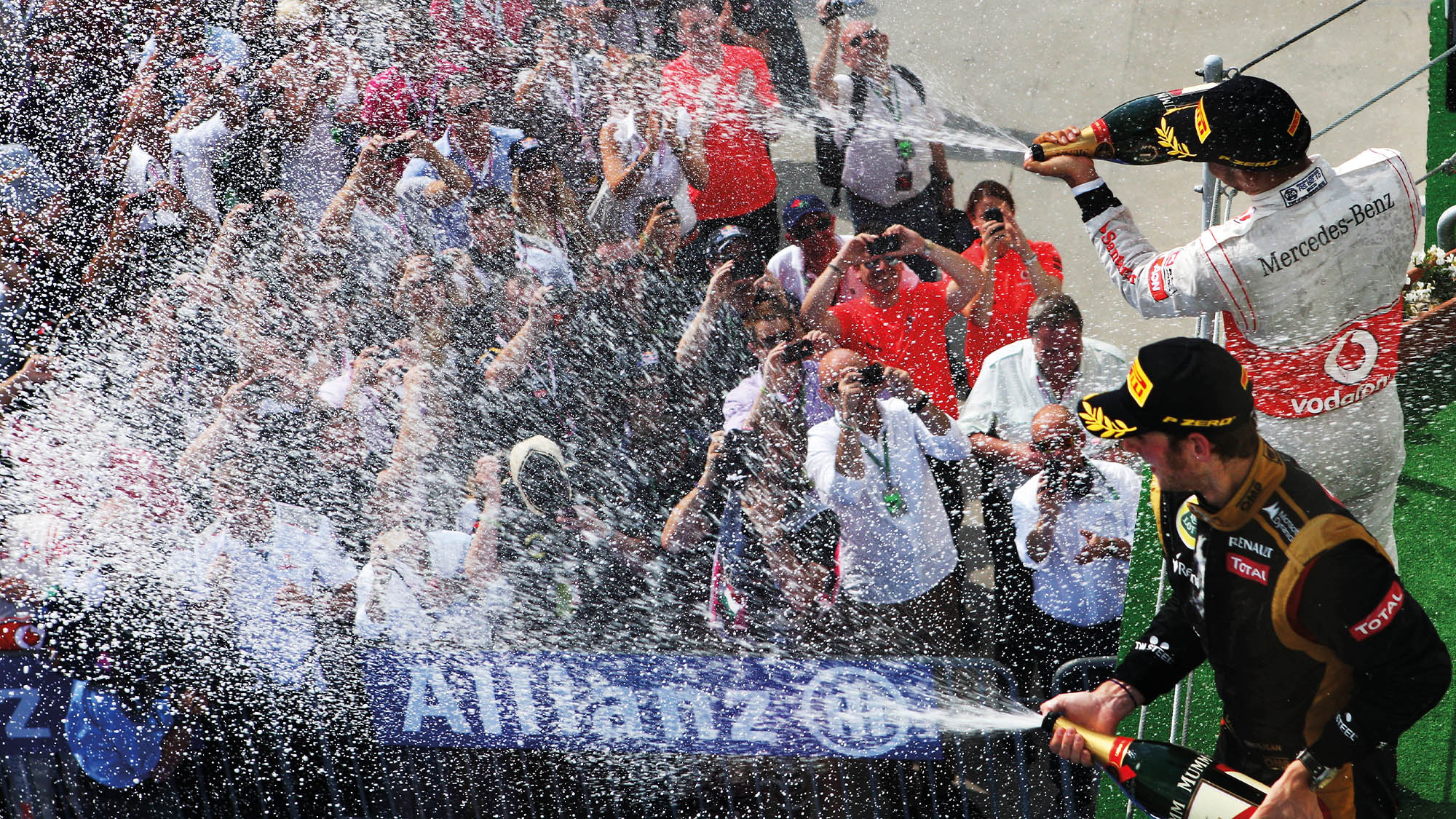
Bubbles at the 2012 Hungarian GP, and Gorsjean’s third podium finish of the season
Grosjean began seeing a sports psychologist at this time and has stayed with her since. He believes it has helped him greatly. In 2013, after a sticky beginning, things began coming good in the season’s second half. At the Nürburgring, he was denied a near-certain victory by the safety car. After tracking Vettel, Hamilton and Räikkönen in the early laps, he upped his pace by half a second when they pitted – and ran for an extra six laps, rejoining just behind leader Vettel. His combination of pace and tyre usage was going to save him a pit stop over Vettel.
“I was following him closely. He was going to need to do three stops. We were going to do two. I effectively had a 20sec lead over him.” Yet again, a safety car cost Grosjean, its timing such that his tyre advantage was wiped. Even then, he almost retook the lead. The Lotus was good but it wasn’t a Red Bull. Grosjean was teasing extra performance from it. He led for a time in Suzuka but was pincered by the split strategy of Red Bull. He finished second in between the Red Bulls in Austin. In Hungary he made a stunning around-the-outside pass on Felipe Massa’s Ferrari and was given a drive-through penalty for exceeding the white lines.
With Lotus fading fast and in a parlous financial state, there was no prospect of a victory. It wasn’t just the team that Grosjean was contracted to. He was also under the management of its owners. “I don’t know if it was my mistake but my management was Gravity, which was owned by the same people as the team. I didn’t really have a manager then and it was my way back in, so I took it. Which was great when the car was competitive in 2012 and ’13. That was the only good car I really had a chance to drive. But when my management was also the team owner they didn’t really have an interest to put me anywhere else, even as the team’s finances died and the car fell to the back. There had been a chance to go to Ferrari in 2014 and with a more independent manager maybe it could have happened, but they chose Kimi. Once you’re in that place, fighting at the back of the field, your career is not over exactly, but you are forgotten about for the top drives.”

Fourth in the 2018 Austrian Grand Prix gave Grosjean his first points of the season, and still stands as the Haas team’s best result
There was one miraculous podium at Spa in 2015 in a car that didn’t deserve to be anywhere near, and with the bailiffs waiting to take it after the race. Quite how he qualified it on the second row remains one of F1’s great mysteries. Without any tempting alternatives, he left for the small team adventure of Haas and produced a few giant-killing performances, but the traits of those cars have tended to put a false ceiling on his speed.
“I need the strong front end to brake aggressively into the corner and take a lot of speed in. But I have never had that in five years. When I first tested the car I was struck by how easy it was. A lot of traction, easy to drive through the corners. But you can’t be aggressive with it on entry. I need that to extract the two-tenths my driving can give me. If I attack the corner the way I want, I’d just understeer off-line and be late on the throttle. So it’s easy but it’s not fast.” This, the frustrated radio calls and the occasional relapse into incident have unfairly made him a figure of fun.
“I hesitate to say this, but even today I am more careful than I should be in how I race just because of all the abuse I have had on social media and people laughing at me. I am a bit more careful than I would be if I was completely free. I’ve been beaten quite badly in the last few years. Stupid things: crashing behind the safety car, crashing in the pit exit. They all have a background explanation, but it doesn’t really matter. The mistake is made. When you don’t have a competitive car you try to overdo it. You drive 101 per cent rather than 99 per cent. It’s likely you’ll make a mistake. Sebastian Vettel, four times world champion and hardly spun once with Red Bull. Now we see he’s human.
“I have made mistakes, I know that. But really sometimes the stars just don’t align and there are only so many things you can control.”
A better management deal, a few less inopportunely timed safety cars, no alternator failure at Valencia in 2012… and the perception would have matched the reality of Grosjean’s true level far more accurately. He’s given F1 a lot, and it’s sad to see him go.
